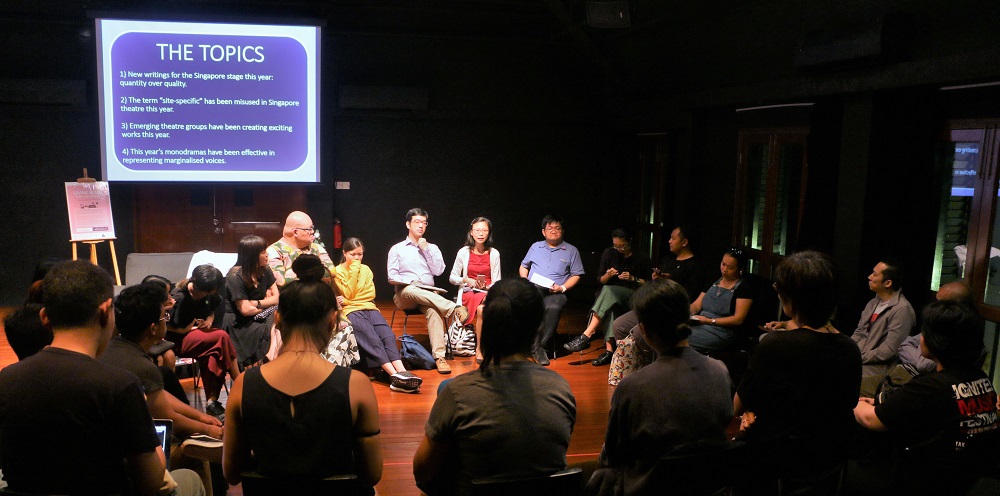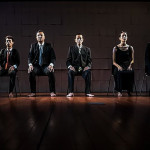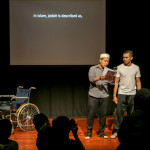
Attendees to “Year in Reviews 2018″ were invited to join one of four groups of reviewers to continue discussions in a more intimate setting.
Over 163 local theatre productions took place in Singapore in 2018, and there was often little time – and space – to pause and reflect on the shows we watched, especially within the context of the wider landscape. With that in mind, Centre 42 and ArtsEquator.com conceptualised the second edition of In the Living Room: Year in Reviews as a platform for the theatre practitioners and enthusiasts to come together, and engage in critical discourse with reviewers from both organisations. The event was held at our Black Box on 4 December 2018, and well attended by old friends and new faces from the theatre community.
Prior to that evening, Centre 42 and ArtsEquator.com worked with our 10 reviewers to identify four topics based on their trends they observed in Singapore theatre last year. They were:
- New writings for the Singapore stage this year: quantity over quality.
- The term “site-specific” has been misused in Singapore theatre this year.
- Emerging theatre groups have been creating exciting works.
- This year’s monodramas have been effective in representing marginalised voices.
These statements were designed to be the starting point for discussions and debate. To encourage more open conversations, we experimented with hosting it in a small-group discussion format, as opposed to a panel. So after reviewers from each of the four groups presented a brief overview of their topics, attendees were invited to join them at various spaces around the house to continue chatting.
This is a summary of what each group went on to discuss, written by the reviewers from Citizens’ Reviews (CR) and ArtsEquator.com (AE).
“New writings for the Singapore stage this year: quantity over quality.”
Facilitated and written by: Christian W. Huber (CR) and Naeem Kapadia (AE)
Local theatre companies have invested time and money in nurturing in new voices through initiatives such as The Wright Stuff by Toy Factory, The Orange Production by The Necessary Stage, and the Playwright Mentorship Programme by Teater Ekamatra. This has resulted in a plethora of original works – some good, some rather dire. The key question is whether companies are putting on shows to meet certain KPIs, or if they truly believe in the work. It’s important for plays to go through a developmental journey before being staged, as there may be a risk of negative feedback if a new, untested play does not fare well. This could turn audiences off and discourage playwrights from writing more. To that end, how does one balance quantity with quality?
Our group interrogated the idea of “quality” as a benchmark of a good play. It was noted that younger audience members have a wide choice and tend to watch plays whose themes resonate with them, rather than purely based on whether it is good or not according to tastemakers or critics. Others argued that the very idea that a play should undergo a ‘process’ to achieve its final potential was somewhat myopic – this formal structure does not work for all plays and ultimately, a raw piece of writing should speak for itself. Some group members also suggested that full-blown stagings should not always be regarded as the end goal for plays. Dramatised readings and showcases that highlight shorter pieces of writing, like Centre 42’s Late-Night Texting and Teater Ekamatra’s Projek Suitcase should also be encouraged.
Some of the original plays of 2018 that resonated positively with the group were Tiger of Malaya, Supervision and Citizen Dog, while those which proved disappointing include 13.13.13 and Press Gang.
“The term “site-specific” has been misused in Singapore theatre this year.”
Facilitated and written by: Isaac Tan (CR) and Jocelyn Chng (CR)
Rather than focusing on specific productions, the conversation in this group broadly centred on three main areas: definitions of “site-specific”, the idea of different players in the field, and how labels and terminology can be problematic. Most people felt that for it to be “site-specific”, a production must take the history, location, and general environment of the performance space into consideration. Another term that came up in the discussion was “site-related”, which perhaps better describes some performances that might be less focused on interrogating the site per se.
The discussion then turned towards questioning the idea of “misuse” – who is misusing the term. We realised that the term “site-specific” has been and can be used by many different sectors involved in the arts ecosystem – artists, audiences, writers, academics, and marketing personnel – all of whom have different perspectives and intentions.
Some practitioners felt that the term limits both artists and audience. It was pointed out that as meanings and practices change over time, such labels do not necessarily represent creative aims adequately. We recognised that the use of labels can be dangerous, especially if writers and critics use terms that can be interpreted differently by different people. It was a good reminder for writers to be more careful in their choices and diligent in their research, as arts writing inevitably performs an educational function for the general reader.
“Emerging theatre groups have been creating more exciting works.”
Facilitated and written by: Cordelia Lee (CR) and Lee Shu Yu (CR)
The session garnered insightful and heart-warming reactions from a diverse group consisting of producers, reviewers, emerging and seasoned artists. We agreed that it was not the age of the group members, but relative experience in their respective collectives/roles that defined “emerging”.
We discussed how emerging groups tend to fill a gap in the theatre landscape, either by pursuing a niche genre/topic, or by responding to prevailing and dominant products in the market. Works created by young, new, and/or independent artists can also be more exciting because they are still in the early stages of searching for an identity. They have lower stakes and more freedom to pursue diverse creative paths, and they often find innovative ways to circumvent production limitations.
Plays by emerging groups that we especially enjoyed include Stupid Cupid (Patch and Punnet) for its hilarious use of cardboard set, and The Taste of Water (Bound Theatre) for its well-executed choreography.
However, the discussants also felt that some productions by emerging groups have disappointed them by attempting to do too much with too little. One example given was an unnamed production at the Drama Centre, which tried too hard to replicate a full-scale performance – complete with a proper set and a few veteran actors – and ended up creating an unbalanced audience experience.
The session concluded with the view that theatre-makers should find and hold on to the high energy and sense of play exemplified by the emerging theatre groups from this year, to continue creating works that excite.
“This year’s monodramas have been effective in representing marginalised voices.”
Facilitated and written by: Akanksha Raja (AE), Liana Gurung (CR), and Patricia Tobin (AE)
With its deliberately emphatic phrasing, this topic drew a group of roughly 15 theatre makers and goers, and catalysed a discussion that proved the innate power of the monodrama in inviting profound personal and emotional engagement. We discussed the politics of production, and how the monodrama form allows stories that are usually excluded from mainstream narratives to be heard.
Our conversations also ventured into the ethics of representation. What kinds of stories should be told? Who are these stories being told to or for? An observed trend was succinctly summed up by a member of the group: the rise of the “brown girl voice”, which we followed with an examination of how the power and potential of a piece might be undercut by co-creators (director, scriptwriter, actor) who do not share common backgrounds and experiences. Among the handful of performances from 2018 that surfaced during the discussion were Building a Character and An Actress Prepares (both from the Singapore Theatre Festival), and the presentation of queer issues in I am trying to say something true (from the Esplanade’s The Studios series).
Of the statement itself, we did not come to a consensus. Indeed, most of the group was split on the shows we felt were compelling and effective or not, possibly due to our own diversity in background and experiences. Yet all recognised the potential of the monodrama as disruptor and as space held for lesser-heard stories, leading perhaps to heightened expectations that seem to have yet to be fully met.
Published on 10 January 2019
In the Living Room: Year in Reviews 2018 took place at Centre 42’s Black Box on 4 December 2018. Find out more about the event and watch the video recording of it here.





